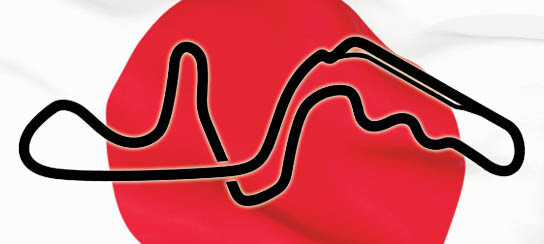BIOGRAPHY
Japan wanted a Grand Prix as its fan-base became enormous, and everyone wanted Japan to have a Grand Prix because there were potential sponsors and engine-builders there, but nobody wanted to race at Fuji. The answer was Suzuka, which had been designed by John Hugenholtz as a test track for Honda.
Because it had been designed as a test track, it had a wide range of corners over its 3.641 miles and it also had a feature unique to Grand Prix circuits, a crossover.
Suzuka was first used for a World Championship race in 1987 and hosted the Japanese Grand Prix until 2007, and again in 2008, in favour of the Toyota-owned Fuji Speedway after it underwent a transformation and redesign by Hermann Tilke.
Suzuka and Fuji were to alternate hosting the Japanese Grand Prix from 2009. However, after Fuji announced in July 2009 that it would no longer be part of the calendar, Suzuka signed a deal to host the Japanese Grand Prix exclusively.
The circuit has been modified a couple of times. In 2002, the chicane was slightly modified, 130R was also modified and some of the Snake curves were made a bit straighter and faster. In 2003, the chicane was made slightly faster and closer to the 130R.
Suzuka has frequently seen the Championship decider, never more dramatically than in 1989, when Alain Prost suckered Ayrton Senna and then drove into him, or in 1990 when Senna rammed Prost out of the race at very high speed on the first corner. Japan, after all, is the home of kamikaze.
The 2014 event was marred by the tragic accident which was to eventually claim the life of Jules Bianchi. Circumstances surrounding the incident caused much soul-searching within the sport, and while the introduction of closed cokcpits is still bering debated, within weeks of the crash a new Virtual Safety Car procedure was introduced.
Fast Facts - Provided by the FIA
2018 marked the 34th Japanese Grand Prix, and the 30th to take place at Suzuka. The race debuted at the Fuji Speedway in 1976 and hosted a second edition in 1977 before dropping off the schedule for a decade. The race returned in 1987 at Suzuka and save for a brief spell at Fuji in 2007 and 2008, it has been staged at the Mie prefecture circuit each year since.
Michael Schumacher is the most successful driver at the Japanese Grand Prix with six victories, winning for Benetton in 1995 and Ferrari in 1997, 2000, 2001, 2002 and 2004. Second on the list are current drivers Sebastian Vettel and Lewis Hamilton, both of whom have four Japanese GP wins.
McLaren are the most successful team at the Japanese Grand Prix with nine victories. Two of those victories are, however, at Fuji, James Hunt's 1977 win at the track being scored 30 years prior to Hamilton's. At Suzuka McLaren are tied with Ferrari on seven wins each.
Hamilton and Fernando Alonso are the only drivers to have scored Japanese Grand Prix victories at two different venues. The first of Hamilton's four wins in Japan was scored at 2007 at Fuji, with McLaren, while the others came at Suzuka in 2014, 2015 and 2017, with Mercedes. Alonso won at Suzuka in 2006 and then at Fuji in 2008, both with Renault.
Apart from Hamilton, Vettel and Alonso, Kimi Raikkonen is the only other current driver with a Japanese Grand Prix win to his name. The Finn won in 2005 for McLaren.
Michael Schumacher also holds the record for Japanese GP pole positions with eight. It's not only a Japan and Suzuka record but also a joint record for most poles for a driver at any grand prix. Schumacher shares the record with Ayrton Senna who was on pole eight times at the San Marino Grand Prix.
Statistically, pole position is not crucial for victory at Suzuka. In its 29 grands prix to date, the man on pole position has won 14 times. Second position on the grid has yielded victory 11 times. Only Raikkonen has won from further back than sixth on the grid. He scored his 2005 victory from a starting place of P17.
Alonso is this weekend set to take sole ownership of second place on the list of drivers with the most F1 starts. Sunday will be the 307th F1 start and will move him one ahead of Michael Schumacher and Jenson Button. Rubens Barrichello holds the record, with 322 starts.
Alessandro Nannini is the only driver to take a maiden F1 win at the Japanese Grand Prix. However, five drivers have scored their maiden podium finish at this race: Roberto Moreno and Aguri Suzuki in 1990, Mika Hakkinen in 1993, Heikki Kovalainen in 2007 and Kamui Kobayashi in 2012. Only three Japanese drivers have scored podium finishes in F1: Suzuki and Kobayashi at their home race and Takuma Sato who finished third at the 2004 US GP.
In all, 20 Japanese drivers have made F1 appearances, with 17 making grand prix starts. The most prolific is Ukyo Katayama who made 94 starts between his 1992 debut in South Africa and his final race, the 1997 European Grand Prix. Across those six season he scored five points, finishing fifth at the Brazilian and San Marino races in 1994 and sixth at the British Grand Prix in the same year.


